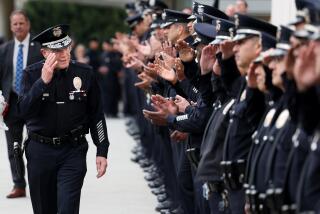Stamper Envisions Kinder, Gentler Police Force in the ‘90s
The title of the senior thesis by San Diego State University student Norman Stamper in 1974 left no doubt as to his opinion about police work. It was called: “The Community as DMZ (demilitarized zone): Breaking Down the Police Paramilitary Bureaucracy.”
Fourteen years later, in his 342-page doctoral dissertation, then-Deputy Police Chief Stamper elaborated upon the problems associated with having police departments patterned after the military.
Therefore, it should have been no surprise this month when Stamper, now assistant chief, concluded that the centerpiece of the department’s blueprint for the 1990s should include an end to its paramilitary culture and the softening of traditional duties and titles.
The reaction against the idea was fierce.
The suggestion that duty lieutenants be known as “assistant division directors” and sergeants as “supervising agents” left police officers cold and generated a wave of humorous examples of new law enforcement terms under the derisive heading of “Normanclature.”
Police name tags, officers joked, would be called “nonverbal introductory devices.” Badges would be “metallic numerical modules.” Guns were “defensive projective dispensers.” Vests were “hostile projectile deflection and absorption devices.”
While officers acknowledged that Stamper’s six-month study yielded a crop of innovative ideas that far outweighed the bad, many have become fixated on the title changes and how alterations in rank and structure will affect them personally.
And among the questions about the reorganization are those that focus on Stamper’s motives in light of Chief Bob Burgreen’s statements that he will retire within two years.
“I think someone is setting up to become the next chief,” said Harry O. Eastus, president of the Police Officers Assn., the department’s union.
“Most police officers don’t look at him as being a cop,” he said. “They think he’s more of an ombudsman. He’s about 15 years behind the times trying to run the department like a corporation.”
Despite his reservations, Eastus, among others, believe Stamper put his finger squarely on most of the problems big-city departments face today: a bloated, top-heavy bureaucracy; a dearth of cops on the street; communication distorted by too many managerial levels; captains who have no real power but are saddled with the heavy, attendant responsibilities.
Had those proposals alone been included in Stamper’s report, police officers might have saluted his inventiveness and gone about their business.
But Stamper’s recipe for rearranging the San Diego Police Department struck a nerve for men and women drawn to the profession for its sense of strict organization and order--something they held sacred--and which they now saw in jeopardy.
“He wants to demilitarize when every organization wants a Norman Schwarzkopf to make them more militaristic,” said robbery detective Steve McMillan. “What we don’t need is for people in the department to become more touchy-feely, put on blazers and start becoming social workers.”
Rank structure is essential, McMillan and others say, especially in explosive situations such as the San Ysidro massacre in 1984 where someone in charge needs to make quick decisions.
“When you’re in the field and the chips are down, what are we supposed to do? Say ‘Hey Jim, what do you think?’ And have a committee meeting about it?” McMillan said. “We need the military outlook in training and in expertise. It’s called discipline.”
Adds former Police Chief Ray Hoobler: “People have to know to whom they are responsible. (Stamper) related police officers to (military) privates. What’s wrong with being a private, so long as you’re a good one and proud of what you do?”
Such opinions rankle Stamper, who believes his proposal may be getting lost in the translation. For example, he does not espouse an end to police hierarchy and control. Under his plan, officers still will have assigned duties and report to superiors.
Furthermore, his approach envisions a share of authority for every member of the department rather than concentrating it in the hands of a few who are out of touch with police work in the 1990s, he said.
“The most successful of companies and organizations share power but ultimately, the boss is responsible,” Stamper said. “I’m the last person in the world to say that police administrators give up their control. That’s a reckless position. But the more police officers are involved, the more likely they are going to commit on an emotional level.”
The danger in the way the San Diego Police Department, and almost all others, operate is that a militaristic approach “discourages disagreement and honesty and tends to promote yes people,” Stamper said.
“We are an institution designed to keep the truth from the boss, an institution that can’t meet its mission to the satisfaction of anyone, that is full of wasted energy, wasted creativity, wasted imagination, all as a result of our paramilitary bureaucracy,” he said.
Stamper’s vision for a new police force was influenced by former Atty. Gen. Edwin Meese III, now a distinguished fellow with the Heritage Foundation, a public policy research and educational institution in Washington.
Earlier this year, Meese conducted a seminar in modern policing at the John F. Kennedy School of Government at Harvard University, and that talk found its way to San Diego.
His thoughts centered on the trouble with treating police beat officers as Army privates, when, in fact, they have a great deal more responsibility.
“We should think of police officers as aviators,” Meese said in an interview last week. “They have a tremendous responsibility, such as the inherent risks in flying a plane. In a police department, the rank of police officer is just not commensurate with the responsibility they have.”
Stamper, Meese and others agree that police officers should have myriad ranks and pay structures that should allow them to remain in positions they prefer, rather than aspiring to higher supervisory ranks.
Some officers agree that staying in one job should be acceptable, so long as pay is increased with each new challenge.
But they take exception to Stamper’s contention that those in the department consider themselves part of the military. Nor do they believe there is a breakdown in communication to the extent Stamper has asserted or that officers don’t have a voice in decision-making.
“If your boss has certain expectations, you should meet those expectations and not be afraid to talk,” said Homicide Lt. Dan Berglund. “Nobody here goes marching off blindly. Within my group, at least, there’s a lot of discussion.”
Other than the change in titles, officers are most leery of “customer-satisfaction surveys” which Stamper has proposed would go out to anyone who has dealings with the department, including those arrested.
“What are we going to ask? Are you satisfied with the way we kicked your door in? Were you handcuffed satisfactorily?” Eastus asked. “How many people do you think are happy about the way they were arrested?”
Throughout his report, however, Stamper emphasizes a need to return to “community-oriented policing,” which puts a premium on putting more cops on the street and getting to know the neighborhoods they patrol.
Such a practice, his report says, “is just beginning. It is not being well received by a majority of department personnel, most of whom see the chief as ‘selling out’ to politicians, the media, and ‘special interest’ groups, especially people of color.”
San Jose Police Chief Joseph McNamara, who is retiring at the end of this month after nearly 15 years in the top spot, said “community-oriented policing” is an important concept because it breaks down the mystique of police to the areas they serve.
“Anything you can do to avoid the kind of view that people have that you’re some sort of occupational army is the direction you want to go,” he said. “That way, you’re emphasizing police as people, not just as a person who is out to arrest you.”
San Diego police officers, including Chief Burgreen, are eager to try out a number of Stamper’s ideas: doing away with some specialized units as a way of returning more officers to the street; eliminating two ranks of command to reduce the bureaucratic levels from seven to five; to be more selective about who the department hires, and to develop a mission statement.
Whether Stamper’s ideas, especially the most controversial, will work is anybody’s guess.
No department in any large city has ever done away with conventional titles and fully moved away from a militaristic approach, according to Darrel Stephens, executive director of the Police Executive Research Forum, which includes 450 police administrators.
In some isolated incidents in the 1960s and ‘70s, small departments issued blazers to its force and switched titles, but the experiments were short-lived.
“Nobody has yet been willing to really take this on and make some serious adjustments until now,” Stephens said. “What (Stamper) is exploring is a department’s greatest fear--change.”
For his part, Stamper acknowledges that he has heard “ridicule and derision” about some of his recommendations but “for a pointy-headed intellectual, I’m very tough. I don’t shrivel up and die if (Burgreen) says we don’t do some of these recommendations.”
And Stamper said his program is not designed to propel him into the chief’s office.
“I don’t work that way. I don’t have my sights set on Bob’s job,” he said. “I want to transform this department into one that is just dynamite. After all, I’ve been teaching and preaching this for nearly 20 years.”
More to Read
Sign up for Essential California
The most important California stories and recommendations in your inbox every morning.
You may occasionally receive promotional content from the Los Angeles Times.










